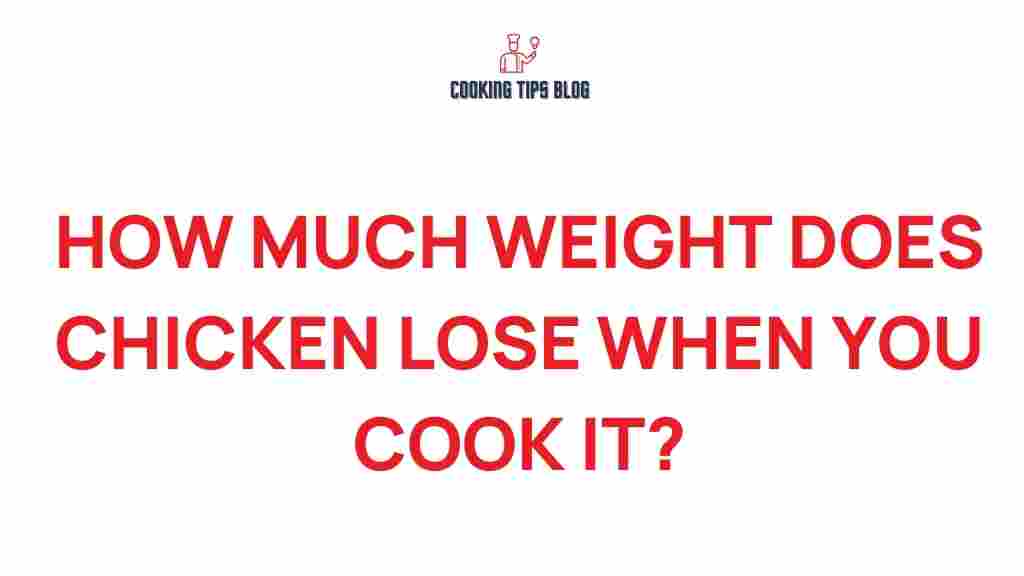The Surprising Truth: How Much Weight Chicken Loses When Cooked? – Understanding Chicken Weight Loss
When it comes to cooking chicken, many home cooks find themselves pondering an important question: how much weight does chicken lose when cooked? This question is not only crucial for meal planning but also plays a vital role in understanding portion sizes, nutrition, and overall cooking results. In this article, we’ll dive deep into the science behind chicken weight loss during cooking, providing you with fascinating insights and practical tips to ensure your meals are both delicious and nutritious.
Understanding Chicken Weight Loss
Chicken weight loss refers to the reduction in mass that occurs when chicken is exposed to heat. This phenomenon can vary based on several factors, including cooking method, temperature, and duration. Understanding how much weight chicken loses when cooked can help you make informed decisions about portion sizes, meal planning, and nutritional content.
Factors Influencing Chicken Weight Loss
Several factors contribute to the weight loss of chicken during cooking. Let’s explore these factors in detail:
- Cooking Method: Different cooking methods can lead to varying degrees of weight loss. For example, roasting, grilling, and frying often result in more moisture loss compared to poaching or steaming.
- Temperature: Cooking chicken at higher temperatures can cause it to lose moisture more quickly, leading to a greater reduction in weight.
- Cooking Time: The longer you cook the chicken, the more moisture it will lose. Overcooking can significantly impact texture and taste.
- Starting Weight: The initial weight of the chicken can also influence the percentage of weight loss. A larger piece may lose more weight in absolute terms than a smaller piece.
How Much Weight Chicken Loses When Cooked?
Generally, chicken can lose anywhere from 15% to 30% of its weight when cooked, depending on the factors mentioned above. Here’s a breakdown of weight loss based on common cooking methods:
- Grilling: Approximately 20-30% weight loss
- Roasting: Approximately 20-25% weight loss
- Baking: Approximately 15-20% weight loss
- Boiling/Poaching: Approximately 10-15% weight loss
It’s essential to note that these percentages can vary, so using a kitchen scale before and after cooking can provide precise measurements for your specific situation.
Step-by-Step Process of Weighing Cooked Chicken
To accurately determine how much weight chicken loses when cooked, follow this step-by-step process:
- Weigh the Raw Chicken: Use a kitchen scale to measure the raw chicken before cooking. Note this weight for reference.
- Cook the Chicken: Choose your preferred cooking method and prepare the chicken as desired.
- Weigh the Cooked Chicken: After cooking, allow the chicken to rest for a few minutes, then weigh it again.
- Calculate Weight Loss: Subtract the weight of the cooked chicken from the weight of the raw chicken to find the total weight loss.
Common Cooking Methods and Their Impact on Chicken Weight Loss
Let’s take a closer look at various cooking methods and how they affect chicken weight loss:
1. Grilling
Grilling is a popular cooking method that imparts a smoky flavor to chicken. However, it can lead to significant moisture loss, resulting in a weight reduction of about 20-30%. To minimize weight loss, avoid overcooking and marinate the chicken beforehand.
2. Roasting
Roasting chicken in the oven is another common method that can yield crispy skin and juicy meat. Expect a weight loss of around 20-25%. Using a roasting pan with a lid or covering the chicken with foil can help retain moisture during cooking.
3. Baking
Baking chicken is a great way to achieve even cooking without excessive moisture loss. This method typically results in a 15-20% weight loss. Consider using a baking dish that traps steam to keep the chicken moist.
4. Boiling/Poaching
Boiling or poaching chicken is a healthier option that results in the least weight loss, usually around 10-15%. This method not only retains moisture but also helps preserve the nutrients in the chicken. It’s an excellent choice for soups or salads.
Troubleshooting Tips for Reducing Chicken Weight Loss
If you find that your chicken frequently loses too much weight during cooking, consider these troubleshooting tips:
- Use a Meat Thermometer: Ensure you’re not overcooking by checking the internal temperature. Chicken should be cooked to an internal temperature of 165°F (75°C).
- Marinate Before Cooking: Marinating chicken can help lock in moisture, resulting in a juicier final product.
- Cover While Cooking: Using a lid during cooking can trap steam and prevent moisture loss.
- Avoid Thawing at Room Temperature: Always thaw chicken in the refrigerator to maintain its moisture content.
Conclusion
In conclusion, understanding chicken weight loss is essential for home cooks who want to optimize their cooking methods and meal planning. By being aware of the cooking methods and their impact on weight, you can make informed decisions that will enhance the taste and nutritional value of your meals. Remember that chicken can lose between 15% to 30% of its weight when cooked, so adjusting your portion sizes accordingly is crucial.
For more insights on cooking chicken and other culinary tips, check out our cooking resources. If you’re looking for nutrition information, visit the USDA website for comprehensive data.
Now that you have a better understanding of how much weight chicken loses when cooked, you can confidently prepare delicious dishes while ensuring you meet your nutritional goals!
This article is in the category Tools and created by Cookingtipsblog Team
